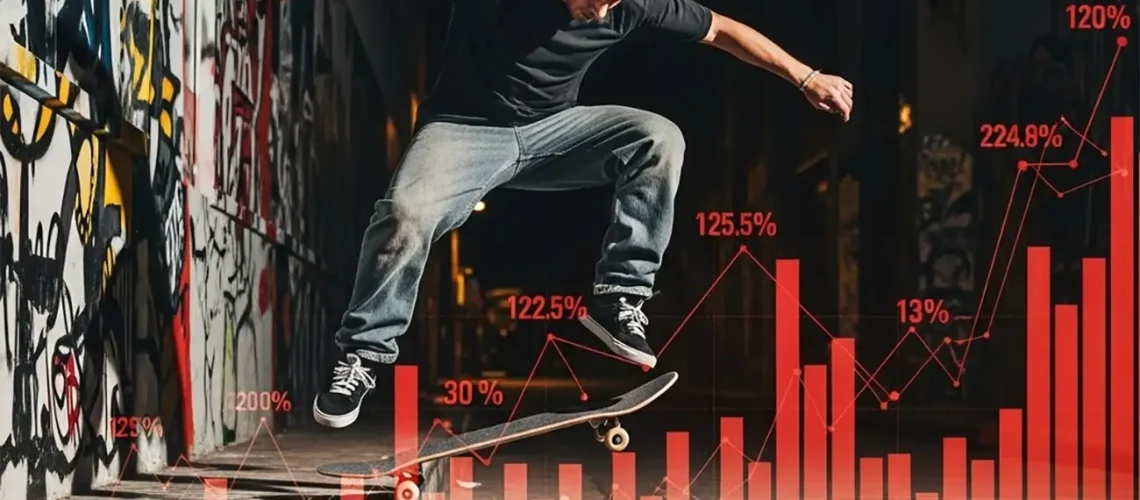The Rise of Authentic Brands and the Creeping Decline of Values
Action sports brands like Quiksilver, Billabong, or Volcom once emerged “from riders for riders” – shaped by surf, skate, and snowboard pioneers who lived for their scene. Quiksilver, for example, was founded in 1970 to produce innovative boardshorts for surfers. Billabong started in 1973 with robust, triple-stitched shorts in surf pioneer Gordon Merchant’s backyard. Such brands became cult labels; in the 1980s and 90s, pro riders proudly wore their logos, and the culture was paramount. Quiksilver was even the first surf company to go public in 1986 and sponsored legendary contests like “The Eddie” in Hawaii. Billabong funded daring projects like the Odyssey in search of the 100-foot wave. Authenticity was their capital.
But with commercial success came a creeping decline in values. By the 2000s at the latest, external investors and large corporations pushed their way into the surf and skate industry. Surf fashion became mass-compatible, especially after the 2002 Hollywood film “Blue Crush” – “after Blue Crush, surfing was hip, countless average Americans flocked to shopping malls to copy the oceanic fashion look.” Quiksilver’s revenue exceeded $1 billion for the first time in 2004 and even reached $2.5 billion in 2008. The flip side: the brands lost exclusivity and cultural purity as they produced for the mass market. Insiders say that surf and skate clothes were suddenly worn by “landlubbers” – people far from the coast and the scene – which diluted their former cult status.
At the same time, the founders made way for corporations. Vans, originally a small skate shoe shop in California, was swallowed by apparel giant VF Corp (including The North Face) in 2004 for $396 million. DC Shoes, founded by skateboarders in 1994, landed at Quiksilver in 2004 for $87 million. Volcom – known for its anti-establishment credo “Youth Against Establishment” – sold itself to luxury fashion group Kering (Gucci, Yves Saint Laurent) in 2011 for a proud $608 million. Ironically, Volcom suddenly belonged to the establishment itself. Such acquisitions brought fresh capital, but also a new priority: shareholder value over scene relevance.
Private Equity Buys: Profits Over Credibility
In the 2010s, the formerly booming action sports giants ran into economic difficulties – and private equity investors sensed their opportunity. Quiksilver had overextended itself: after peaking in revenue in 2008, it diversified recklessly. The acquisition of ski manufacturer Rossignol for $560 million ended in 2008 with a loss of around $400 million upon resale. High debts and the 2008/09 financial crisis brought Quiksilver to its knees: 2009 saw mass layoffs, rating downgrades, and finally, in 2015, the Chapter 11 bankruptcy filing in the USA. The Californian surf giant was insolvent and was rescued by financial investor Oaktree Capital.
Oaktree – the world’s largest distressed debt investor – stepped in with $175 million and took a majority stake in Quiksilver. In 2016, a new holding company called Boardriders Inc. was formed for Quiksilver and its subsidiary brands. Oaktree openly pursued not an idealistic surf dream, but hard-nosed return targets: “Oaktree’s philosophy is simple – instead of betting on the next big winner, they buy established companies in trouble, fix shortcomings, and thus reliably generate profit.” In other words: short-term value appreciation over long-term cultural preservation.
Billabong, Quiksilver’s Australian arch-rival, suffered a similar fate. Between 2004 and 2012, Billabong itself went on a buying spree: everything from skate brands like Element and Plan B to surf equipment manufacturer Dakine was swallowed. But in 2012, the empire spectacularly collapsed – an annual loss of AUD 859.5 million (over €600 million) wiped out the brand’s value. Only emergency loans from financial investors Oaktree and Centerbridge (approx. 19% stake each) saved Billabong from bankruptcy in 2013. The company was heavily indebted and fought a years-long struggle for survival; in 2017, it again posted losses.
Finally, in 2018, Oaktree pulled the plug and united the two battered competitors under its roof: Boardriders (Quiksilver) acquired Billabong for around AUD 200 million (only approx. €130 million) – a bargain price for two formerly billion-dollar brands. Billabong thus lost its stock market listing and was fully integrated into the private company. Oaktree manager Dave Tanner – a turnaround specialist from outside the industry – took over as CEO of Boardriders. Officially, Billabong’s managers at the time asserted that the merger would “protect and enhance the authenticity and tradition of the brands.” Unofficially, however, it was clear: now financial players, who had little to do with surfing, were dictating the direction.
Loans instead of creativity: The merger was financed through high-interest loans from large banks. Oaktree nearly doubled its investment, got its own loans repaid, and forged the largest surf conglomerate in history. But the goal was never a cultural fresh start, but a strict restructuring to resell the companies as profitably as possible. An insider soberly describes the attitude: “You just try to figure out how to generate growth – that’s the only way you can justify your own existence.” Everything that wasn’t efficiently profitable was now scrutinized.
When the Soul Falls By the Wayside: Loss of Quality and Credibility
With the entry of investors, the quality and credibility of the brands inevitably suffered. After the Quiksilver-Billabong merger, the usual “integration” followed: store closures and rightsizing – a euphemism for layoffs. Hundreds of employees lost their jobs to dismantle duplicate structures. An internal memo warned employees not to speak to the media. Nevertheless, many complained anonymously about the new culture: at Billabong, there had been “only fear for a long time.” Trust in the new bosses was low – their lack of connection to the scene was too obvious. “Anyone who comes in here without a surf background probably didn’t make it anywhere else – otherwise they wouldn’t be with us, but with IBM,” one employee scoffed at the new managers. The statement shows the chasm between the old rider culture and the suit-wearing executives who were now in charge.
Sponsorship and product development, in particular, bled out. Marketing budgets were cut, athlete contracts were terminated or merged. Boardriders, for example, planned to appease team riders with multi-brand deals – meaning an athlete would endorse Quiksilver, Billabong, and DC Shoes simultaneously, but not earn more overall. Such synergies save costs, but often mean lower salaries and less variety for athletes. The once proud commitment to “Support the scene” gave way to a cold cost-benefit analysis.
Insiders also notice a downward trend in products. While surfer founders like Bob Hurley or Jake Burton once personally stood for innovation and quality, controllers now ruled the roost. Quiksilver moved many productions to low-wage countries and focused on mass collections for outlet chains – which industry insiders interpret as a drop in quality. Billabong followed similar paths; it became known that they produced separate, cheaper collections for large retailers, which diluted the brand image. A long-time observer of the surf industry commented in 2018: “If you don’t have a distinct brand identity in the surf space, you don’t have much.” But precisely this identity was lost through homogenization.
The result: cultural alienation. In the boardsports scene, Quiksilver & Co. are now widely considered sellout brands – once cool labels that sold their soul. Core surfers and skaters, who were once regular customers, are turning away. “The whole story questions the very existence of giant ‘core’ surf brands,” wrote Stab magazine after the Quik-Billabong merger. Since real surfers remain a small target group worldwide, such brands would inevitably have to appeal to non-surfers to grow – but by doing so, they lost their appeal to the core scene. A vicious circle: at the peak of their commercialization, the brands were ubiquitous, but that very ubiquity destroyed their street credibility. What good is a surf logo that every mall shopper wears and has nothing to do with actual surfing? – “A wave print on a T-shirt doesn’t make a core brand,” Stab aptly scoffs.
The economic consequences of this loss of credibility were not long in coming. Quiksilver and Billabong posted losses for years, and even after the merger, recovery failed to materialize. From 2020 to 2022, the pandemic caused further setbacks in retail. Oaktree sought a quick exit: in 2023, Boardriders (including Quiksilver, Billabong, Roxy, DC, RVCA, Element, etc.) was sold to the next investment group – Authentic Brands Group (ABG), a conglomerate specializing in acquiring heritage brands and licensing their names. ABG owns dozens of labels from Juicy Couture to Aéropostale. For the surf industry, this definitively marked the step from scene label to mere brand in a brand portfolio.
Barely half a year after the takeover, the next blow came: ABG partner Liberated Brands, which was supposed to manage the operations of Volcom, Quiksilver, Billabong & Co., filed for bankruptcy in February 2025. Over 1,400 employees were laid off and stores liquidated. According to court documents, the reasons were outstanding licensing fees to ABG and a debt pile of over $226 million. The private equity chapter thus ended in the next bankruptcy – a cycle of acquisition, over-indebtedness, sell-off, and another crash. This confirms: when a brand’s soul suffers, the business also suffers in the long run. What looked profitable as a short-term financial deal ultimately led to disoriented brands, disappointed fans, and destroyed substance.
Danger at Any Cost? – How Sponsors Drive Extreme Athletes
Not only economically, but also ethically, the sellout of the action sports world is drawing criticism. A particularly grim chapter: the marketing of increasingly daring extreme sports stunts to keep the profit and PR machine running. Red Bull – originally an energy drink manufacturer that has evolved into the biggest promoter (and marketer) of extreme sports over the last two decades – is the focus here. With its slogan “Red Bull gives you wings,” the company sponsors base jumpers, wingsuit flyers, motocross riders, big-wave surfers, freeride mountain bikers, and other adrenaline junkies. The spectacular events and videos ensure worldwide brand presence – but the price can be high. Even at Red Bull, business people have moved in, and the “cool” scene people in the company have left or been fired. Internally, Red Bull now compares itself to Coca-Cola or Pepsi. They invest in Formula 1 and football teams but unfortunately still push extreme athletes to perform very special stunts.
Since 2007, numerous athletes in Red Bull-sponsored activities have died. By 2013, seven fatalities were associated with Red Bull events. These included 14-year-old motocross prodigy Toriano Wilson, who was run over at a Red Bull junior race in 2008. In 2009, Swiss base jumper Ueli Gegenschatz died tragically after jumping from a skyscraper in Zurich – the wind slammed him against the facade. This sparked outrage in Switzerland: “This is an unbearable symbol of the cynicism and perversion of event marketing,” advertising expert Hermann Strittmatter fumed in a documentary at the time. Strittmatter used even stronger words: “It is shameful and shows a lack of imagination and creativity when, in marketing, you can’t think of anything better than letting people risk their lives.”
Indeed, the impression arises that some athletes take increasingly greater risks to succeed in the sponsorship race. Pressure for ever more dangerous stunts – these accusations were voiced after, for example, freeskiier Shane McConkey died in a wingsuit base jump in the Dolomites in 2009. Red Bull later released a film about McConkey’s life motto “You have one life. Live it.” – for critics, almost a mockery of the fatal accident. Other incidents also fuel the criticism: in 2013, German broadcaster ARD aired the documentary “The Dark Side of Red Bull,” in which insiders warned about the “rising blood toll” in extreme sports marketing.
A tragic example from recent years is the death of Russian base jumper Valery Rozov. I had the honor of interviewing Valery as one of the last before he died. The 52-year-old – an extreme athlete with over 20 years of experience – wanted to set a new record in November 2017 with Red Bull’s support: a wingsuit jump from the 6,812-meter-high Ama Dablam in Nepal. Rozov had previously completed spectacular projects, such as the world’s highest base jump at the time from Mount Everest (7220m) in 2013. At Ama Dablam, however, something went wrong: Rozov plunged to his death – whether a gust of wind or a material problem was the cause is unclear. His sponsor, Red Bull, officially announced the accidental death and honored Rozov as a visionary athlete. But the sobering truth remains: without the incentive to constantly deliver new “records” and viral extreme videos, Rozov might never have sought this risk. He said at the time, “in our sport, it usually doesn’t look pretty when an accident happens.” Valery left behind a wife and two sons.
Red Bull, as expected, rejects the criticism. They help “extraordinary people achieve their extraordinary goals” – some endeavors simply involve higher risks, Red Bull stated. Of course, this argument conceals that the corporation enormously benefits from precisely these risky records. Professor Norbert Bolz, a communications scientist, commented on Red Bull’s strategy: “No one else dares to elevate dangerous life to such a program.” Extremism becomes the core of the brand as long as it makes the cash register ring.
Beyond Red Bull, there are also concerning developments. Many action athletes feel compelled to deliver increasingly tougher performances to secure sponsorship contracts. At events like the Freestyle Motocross series or the Freeride Mountain Bike contest Red Bull Rampage, athletes regularly suffer severe injuries. In 2015, mountain biker Paul Basagoitia suffered a spinal fracture at Rampage and was temporarily paralyzed – he had tried to continue riding despite a fall to avoid disappointing his sponsor. Such incidents raise questions: Is human life and health negligently being played with here to deliver spectacular images?
The ethical responsibility of brands is coming under scrutiny. A telling contrast: while Red Bull pours billions into extreme sports marketing, the founder of outdoor brand Patagonia, Yvon Chouinard, recently took a completely different path. In 2022, he transferred his company to an environmental foundation – with the motto: “Earth is now our only shareholder.” Patagonia thus deliberately foregoes maximum profits to preserve its values: “We had to find a way to put more money into fighting the crisis while keeping the company’s values intact.” This step by a scene pioneer shows that there’s another way – responsibility over profit – while Red Bull & Co. continue to organize events where “human lives are traded at practically every event of this billion-dollar corporation,” as a Swiss media report pointedly put it.
Counter-Movements: Back to Authenticity and Ethics
Given the commercial and cultural decline of the major brands, counter-movements are increasingly forming. Former industry insiders and athletes are founding new, independent labels that deliberately swim against the investment tide. One example is Vissla, a surf brand launched in 2013 by Paul Naude – the former president of Billabong USA. Frustrated by Billabong’s “corporate” course, Naude wanted to “go back to the roots.” Vissla focuses exclusively on surfing, not broad lifestyle fashion, and relies on a collective of young surfers, shapers, and artists. “The label is meant to be a modern reflection of the early surf era, when brands were founded, worn, and loved by real surfers,” Naude describes the mission. And success proves him right: within a few years, Vissla grew from a niche startup to a fixed player in the surf industry – apparently, many consumers are fed up with the big corporations’ uniformity and are looking for something genuine again.
Similarly, Patagonia, an established outdoor/surf brand, is pursuing an authentic course. Founder Chouinard, himself a climber and first-generation surfer, remained true to the ideal of putting purpose before profit throughout his life. Patagonia is heavily committed to environmental protection, and by effectively giving away the company, Chouinard definitively removes it from the clutches of short-term shareholder interests. Burton Snowboards, founded in 1977 by Jake Burton Carpenter, also remains family-owned to this day and was recently certified as a B-Corporation for sustainable, community-oriented business. Although Burton has remained a large company, it does not have to report to external shareholders – a model that allows a balance between size and authenticity.
In the skateboarding world, small, “rider-owned” brands are experiencing a revival. Skate shoe companies like Lakai or Etnies aggressively promote their independence from multi-sporting goods companies and find favor with skaters who view Nike and Adidas skeptically in the scene. Lakai – Owned and Operated by Skateboarders – is their slogan. Likewise, skateboard manufacturers like Girl, Anti-Hero, or Baker have never sold their roots to corporations – and thus retain a credibility in the core scene that mall sports brands can only dream of. While these independent companies are financially smaller, they grow organically with a loyal following that values core principles more than rapid growth.
Even former giants of the scene are returning: Bob Hurley, who sold his company Hurley to Nike in 1999 (and had to witness Nike passing it on to an investor in 2019), is now investing in new surf brands like Florence Marine X (founded by surf star John John Florence) and IPD. Together with Vissla founder Paul Naude, Hurley recently forged an alliance to jointly strengthen these independent labels. Here, enormous “old school” know-how is bundled to offer an alternative to the dictates of large investors.
Industry experts observe that many of these small brands emerged directly from the ashes of the big ones: “All those small brands – half of them wouldn’t even exist if the big brands hadn’t existed before… The surf landscape has probably gotten better because of it,” says an insider who worked for a large corporation for years. Indeed, several founders of new labels are former employees or team riders of Quik, Billabong & Co. who started their own ventures after the takeovers. The irony of history: the mistakes of the established players are now fueling a return to authenticity. The “big players” have passed their zenith – and in their place, a more diverse ecosystem of smaller, more credible brands is flourishing.
So, What Now?
The decline of formerly authentic action sports brands is a complex lesson. It shows how excessive commercialization – fueled by private equity, stock market pressure, and corporate takeovers – is not only economically risky but can also have devastating cultural consequences. Quiksilver, Billabong, Volcom, Vans, DC, even a giant like Red Bull – they all risked (or are risking) betraying the values on which their fame was built: quality, credibility, soul. Short-term profits and growth at any cost proved to be deceptive: in the end, there were bankruptcies, distress sales, and an alienated core customer base.
But the story doesn’t end in cynicism. Counter-movements in the surf, skate, and snowboard world show that alternatives exist. Brands that preserve or rekindle their founding spirit – be it through independence, sustainable business practices, or genuine respect for athletes – are regaining credibility. They may be smaller on paper, but they play an important role: they hold up the torch of authenticity.
For us consumers and fans, this is a call to critical engagement: let’s support those companies that treat their athletes fairly, respect the environment, and genuinely live the culture – instead of those who risk everything for the next quarterly report. The action sports world is all the richer the more soul its brands possess. And ultimately, as a scene, we decide where to place our loyalty. Because the experience of the last two decades teaches us: if a brand sells its soul, a crash – economic, cultural, and ethical – will follow sooner or later.
Personally, I hardly drink Red Bull anymore. I ditched The North Face immediately after the new investor took over and the resulting decline in quality. Today, I’m saying goodbye to Volcom. I’ll continue to wear my old Volcom gear, but I won’t buy any more; instead, I’ll “invest” my money where my sport, my subculture, nature, and the individual are still respected.






